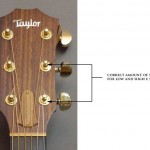The Perfect Amount of Slack When Changing Guitar Strings
My guitar instructor pointed out that my strings were looking a little nasty. I had to admit that it had been a great long time since I had put on new strings. Oh wait, I had never put on new strings. Off to the internet to learn a new skill.
You can find video after video of people changing guitar strings with all kinds of advice but several pieces of advice stood out.
- By putting a small bend in the end of the string with the bushing, you can get it to slide past the end of your bridge pin easier.
- Change one string at a time
- Leave the right amount of slack in the string to leave between 2 and 4 wraps on the tuner peg when the string is tight.
The last piece of advice was the one that I thought could be a little clearer. Lots of comments like, “you’ll just get used to knowing how much slack to leave” weren’t all that helpful. Frankly, I really doubt I would have “got used to it”, because I change strings so infrequently. Isn’t there something more substantial I can use as a gauge?
Yes, there is. Taylor guitars has a video of technicians installing new strings and that provided the information I needed. Essentially you want the slack to be equal to the length from the string’s tuner peg to the next tuner peg. So for the low and high E strings, you would want the strings to reach the tuner pegs for strings A, and B respectively when pulled taught. Instead of cutting them at this length, I just grabbed the string at the length I wanted and pushed it back through the peg to provide the “right amount of slack”, bent the string up and out of my way and then I started to wind the tuner peg. For the D and G strings you will need to just eyeball the length based on the distance between the previous tuner pegs.
Make sure that your string comes up the inside of the tuner peg and that the windings head towards the head stock and not towards the end of the pin. Trim strings as close to the tuner peg as possible and you are done. Stretching your strings several times will prevent new strings from going out of tune.


